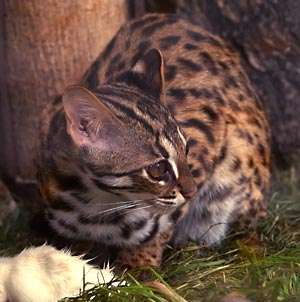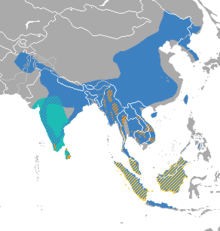Prionailurus
| Prionailurus[1] | |
|---|---|
 | |
| Leopard cat (Prionailurus bengalensis) | |
| Scientific classification | |
| Kingdom: | Animalia |
| Phylum: | Chordata |
| Class: | Mammalia |
| Order: | Carnivora |
| Family: | Felidae |
| Subfamily: | Felinae |
| Genus: | Prionailurus Severtzov, 1858 |
| Type species | |
| Felis pardachrous Brian Houghton Hodgson, 1844 (= Felis bengalensis Kerr, 1792) | |
| Species | |
|
Prionailurus planiceps | |
 | |
| Prionailurus ranges | |
Prionailurus is a genus of four species of small, spotted wild cats found in Asia.[2] They are typically forest-dwelling. Most are able to swim well; some species are actually semi-aquatic and feed mainly on fish and other aquatic animals.
Taxonomic history
Prionailurus was first proposed by the Russian explorer and naturalist Nikolai Severtzov in 1858 as a generic name for a single felid occurring in tropical Asia, namely Felis pardachrous described by Brian Houghton Hodgson — the leopard cat. As varieties, Severtzov lists Felis nipalensis described by Thomas Horsfield and Nicholas Aylward Vigors, Leopardus Elliotti, Leopardus Horsfieldi and Leopardus chinensis described by John Edward Gray, and Felis bengalensis described by Anselme Gaëtan Desmarest.[3]
The British zoologist Reginald Innes Pocock recognized the taxonomic classification of Prionailurus in 1917. In 1939, he described the genus on the basis of skins and skulls, and compared these to body parts of Felis. Prionailurus species are marked with spots, which are frequently lanceolate, sometimes rosette-like, and occasionally tending to run into longitudinal chains, but never fusing to form vertical stripes as in Felis. Prionailurus skulls are lower and less vaulted than Felis, the facial portion is shorter than the cranial, the floor of the orbit is longer, the nasal bones are not everted above the anterior nares, the outer chamber of the bulla is much smaller than the inner. Pocock classified the leopard cat, rusty-spotted cat and fishing cat as belonging to the genus Prionailurus.[4]
Pocock's classification of Prionailurus is widely accepted as comprising:[1]
- Leopard cat (Prionailurus bengalensis)
- Rusty-spotted cat (Prionailurus rubiginosus)
- Fishing cat (Prionailurus viverrinus)
- Flat-headed cat (Prionailurus planiceps)
Molecular analysis of leopard cat populations indicates a clear distinction between northern populations from Tsushima, Korea, Siberia, China and Taiwan and southeast Asian populations. If these genetic differences indicate a specific distinction, P. b. euptilurus may yet be a valid species.[5] The Iriomote cat (Prionailurus bengalensis iriomotensis) has been proposed as a distinct species based on morphology, but is considered a subspecies of P. bengalensis based on genetic analysis.[6]
References
- 1 2 Wozencraft, W.C. (2005). "Order Carnivora". In Wilson, D.E.; Reeder, D.M. Mammal Species of the World: A Taxonomic and Geographic Reference (3rd ed.). Johns Hopkins University Press. pp. 543–544. ISBN 978-0-8018-8221-0. OCLC 62265494.
- ↑ Johnson, W. E., Eizirik, E., Pecon-Slattery, J., Murphy, W. J., Antunes, A., Teeling, E., O'Brien, S. J. (2006) The late miocene radiation of modern felidae: A genetic assessment. Science 311: 73-77.
- ↑ Severtzow, M. N. (1858). Notice sur la classification multisériale des Carnivores, spécialement des Félidés, et les études de zoologie générale qui s'y rattachent. Revue et Magasin de Zoologie Pure et Appliquée 2e Série, T. X Séptembre 1858: 385–396.
- ↑ Pocock, R. I. (1939). The fauna of British India, including Ceylon and Burma. Mammalia. – Volume 1. Taylor and Francis, London.
- ↑ Tamada, T. Siriaroonrat; B. Subramaniam, V.; Hamachi, M.; Lin, L.-K.; Oshida, T.; Rerkamnuaychoke, W.; Masuda, R. (2006). "Molecular Diversity and Phylogeography of the Asian Leopard Cat, Felis bengalensis, Inferred from Mitochondrial and Y-Chromosomal DNA Sequences". Zoological Science. 25 (2): 154–163. doi:10.2108/zsj.25.154. PMID 18533746.
- ↑ Izawa, M. & Doi, T. (2016). "Prionailurus bengalensis ssp. iriomotensis". IUCN Red List of Threatened Species. Version 2016.1. International Union for Conservation of Nature.